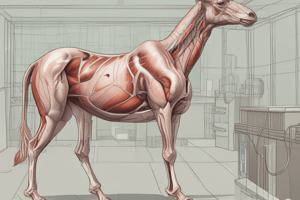Podcast
Questions and Answers
What test is used to distinguish Group A streptococci from other betahemolytic streptococci?
What test is used to distinguish Group A streptococci from other betahemolytic streptococci?
- Bacitracin Susceptibility (correct)
- Bile Solubility
- CAMP Test
- Optochin Susceptibility
Which test involves adding a suspension of suspected S. pneumonia to a solution of sodium taurocholate to observe autolysis?
Which test involves adding a suspension of suspected S. pneumonia to a solution of sodium taurocholate to observe autolysis?
- Bile Solubility (correct)
- CAMP Test
- Bacitracin Susceptibility
- Optochin Susceptibility
Which streptococcal group is identified through the CAMP Test and carotenoid pigmentation under anaerobic incubation?
Which streptococcal group is identified through the CAMP Test and carotenoid pigmentation under anaerobic incubation?
- S. pneumonia
- Group B (S. agalactiae) (correct)
- S. suis
- Group A (S. pyogenes)
Which test involves the use of ethylhydrocupreine HCL to distinguish certain streptococci?
Which test involves the use of ethylhydrocupreine HCL to distinguish certain streptococci?
What distinguishes Group A (S. pyogenes) from other betahemolytic streptococci?
What distinguishes Group A (S. pyogenes) from other betahemolytic streptococci?
Which streptococcal species produces amylase rection?
Which streptococcal species produces amylase rection?
In which natural habitat do Enterococci occur?
In which natural habitat do Enterococci occur?
What distinguishes Enterococcus as a genus from Streptococcus Group D?
What distinguishes Enterococcus as a genus from Streptococcus Group D?
In which strains of streptococci is the CAMP Test effective for identification?
In which strains of streptococci is the CAMP Test effective for identification?
What type of test is performed using a disc diffusion method involving ethylhydrocupreine HCL?
What type of test is performed using a disc diffusion method involving ethylhydrocupreine HCL?
Flashcards
Bacitracin Susceptibility
Bacitracin Susceptibility
Differentiates Group A strep from other beta-hemolytic strep.
Bile Solubility
Bile Solubility
Test using sodium taurocholate to observe autolysis of suspected S. pneumoniae.
Group B Streptococcus
Group B Streptococcus
Identified by the CAMP Test and carotenoid pigmentation under anaerobic conditions.
Optochin Susceptibility
Optochin Susceptibility
Signup and view all the flashcards
Bacitracin Susceptibility
Bacitracin Susceptibility
Signup and view all the flashcards
S. suis
S. suis
Signup and view all the flashcards
Enterococci Habitat
Enterococci Habitat
Signup and view all the flashcards
Enterococcus vs. Strep D
Enterococcus vs. Strep D
Signup and view all the flashcards
CAMP Test Effectiveness
CAMP Test Effectiveness
Signup and view all the flashcards
Optochin Susceptibility Test
Optochin Susceptibility Test
Signup and view all the flashcards
Study Notes
Staphylococcus Species
- Gram-positive cocci
- Facultative anaerobes
- Catalase positive, except for S. aureus subsp. anaerobius and S. saccharolyticus
- Oxidase negative
- Non-motile
- Do not form spores
- Presence of capsules, which may be lost in subculturing
- Colonies are mucoid
- Found on skin, skin glands, and mucous membranes
- Trauma facilitates colonization of tissues
Morphology
- Perfectly spherical, uniform in size (1 μm)
- Irregular masses, resembling a bunch of grapes
Cultural Characteristics
- Grow on blood agar (5%) with characteristic hemolysin production
- Heavily contaminated material can be plated on Mannitol Salt Agar (MSA)
- Inhibits Gram-negative bacteria
- Resistant to salt, saline tolerant
Identification
- Group C, G, and F
- May be β-hemolytic
- Associated with bacteremia, joint infections, pneumonia, and puerperal fever in humans
Genus Enterococcus
- Formerly Streptococcus (Group D)
- Genus Enterococcus was proposed in 1984
- Found in soil, food, water, plants, animals, birds, and insects
- Inhabit the gastrointestinal tract and female genital tract of humans and other animals
Characteristics of Enterococcus
- Grow at 45°C and tolerate 40% bile
- Hydrolyze aesculin
Studying That Suits You
Use AI to generate personalized quizzes and flashcards to suit your learning preferences.




